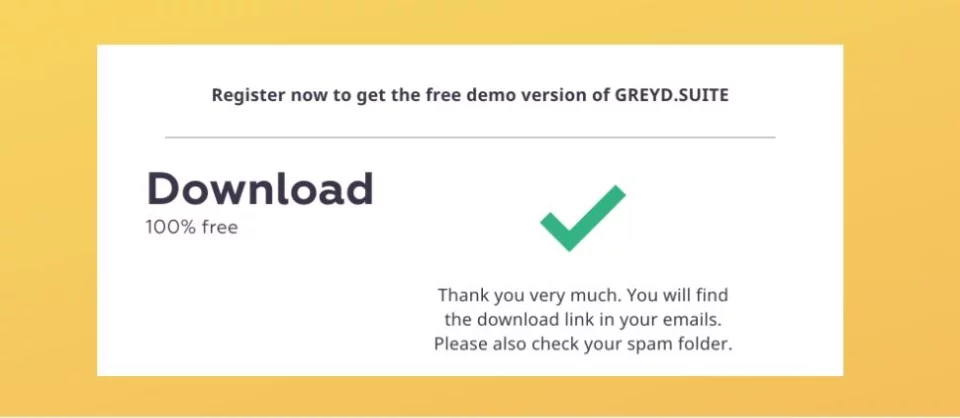Table of contents
Dynamic content has become an indispensable tool for any successful online marketing strategy.
Dynamic content can make you and your website visitors happier. Your users will be happier when shown individual and personalized content, and you’ll be happy about increased leads, clicks, and sales.
Let’s talk about why dynamic content is an absolute must in the digital age – here’s everything you need to know!
What Is Dynamic Content?
With dynamic content, your website’s content is displayed to visitors based on their user behavior. This way, each user only sees the content that actually corresponds to their interests. In comparison, with static web page content all visitors are shown the same thing.
For example, a visitor who came to a page on your website via Facebook would see different content than a visitor who came to the same page via your newsletter.
It’s not about building different pages with different content for each target group. Instead, the structure of the website remains the same, but the content adapts to the visitor!


In marketing, this type of content is used to provide personalized content that is as individual as possible. The visitor of a page should feel addressed as uniquely as possible
This increases dwell time, the quality of the website, and ultimately also the conversion rate many times over.
Why Do You Need Dynamic Website Content?
Dynamically generated content is extremely important for identifying with a company or a brand, and a powerful tool to ensure customer loyalty. This is quite similar to how customers at the bakery or in the butcher’s shop feel unique and important when they are personally addressed by name by the sales staff.
The shopping experience is even more individual if the customer even remembers which bread the customer usually buys or that the sausage should be vacuum-packed. Customer loyalty is no different in the digital world.
By evaluating user data and behavior, the displayed content is designed as individually as possible in order to offer the user the best possible experience.
In simple terms, it can also be said that companies try to use dynamic content similar to everyday offline life: to build a bond with customers. To achieve this, they include an individualized website in everyday digital life.
There is already more than enough regular, non-personalized content on generic websites!
No matter what goals you are pursuing with your website – an increase in visitors, followers, or leads can definitely be achieved through the sensible use of dynamic website content.
Your Benefit From Dynamic Content in Marketing
In marketing, dynamic content is a simple and inexpensive way of increasing customer loyalty and ultimately increasing sales. Individual content can be presented at any time with simple means.
The users have the best possible experience, and the likelihood that the company or brand will be remembered (and that users will visit your site again) increases vastly.
As visitors to the website, we feel personally perceived and addressed by dynamic website content. We like that.
Depending on the intention of the company, the website, the content marketing strategy, the contents of contact forms, but also text, images and videos can be specifically adapted to the user.
By the way: Dynamic content can be perfectly combined with a Headless CMS. That way, you can benefit from the advantages of dynamic content across multiple websites – without having to set up the conditions and content on each website individually.
Examples of Dynamic Web Content
One of the best-known examples of dynamic content is Amazon’s product proposal section. The category “Inspired by your shopping trends” exclusively shows suggestions of articles that actually match our interests – and only because the online shop has noticed our user behavior.

We, as users, usually take this for granted.
In fact, it is extremely pleasant and time-saving for us if we receive a recommendation according to our preferences or current interests. For the company itself, it means higher customer satisfaction and an increase in profits.
With this feature, Amazon showed us how cross-selling works in the digital age – thanks to dynamic page content.
Incidentally, Instagram also uses dynamic content. Most of the channels on the Explore page are actually suggestions based on previous behavior.

If you only follow profiles about nutrition and cute dog pictures, your Explore page is probably filled with very similar content.
Ultimately, these suggestions increase interactions on the platform, and thus they also increase sales – because there are more opportunities to display ads. Incidentally, of course, the user also benefits from it, as they receive new input that’s catered to their interest.
Previous Dynamic Content Solutions
Previous solutions in the area of dynamic content, such as the WordPress-specific solutions from Elementor or Divi, were often a compromise between cost and ease of use.
Dynamic Content for Elementor, Divi & Co.
Building websites dynamically with WordPress plugins is very popular. However, in addition to the advantages of dynamic content, these solutions also have a major disadvantage: The page is “bloated” with too much information.
This means that too many individual parts are often put together without a measure or goal. Content that is not relevant to the user is often included as well. The page speed decreases rapidly, and for this reason, creates frustration among visitors.
The goal that dynamic content pursues – to give users the best possible browsing experience – is clearly missed. Even the workaround with WP Rocket for dynamic content doesn’t help to improve the performance of the site.
Additionally, dynamic content features like those from Elementor do not necessarily describe the same feature that we have described here in the article. When page builder plugins speak of “dynamic content blocks”, they usually mean very specific use cases – for example the dynamic use of blog titles, reviews or an author box. You can then revise these in one instance, and they will be automatically adjusted in all the other instances.
Adapting content to your website’s visitors depending on their interests and user behavior is not even possible with most WordPress page builders.
One Solution for Dynamic Content in WordPress
With the dynamic content feature of GREYD.SUITE you can easily build professional dynamic web pages for all your visitors.
As a company, you no longer have to ask yourself the question: simple and reasonably priced, or individual and expensive?
Also, if necessary, you can adapt every single block with dynamic content without the need for a programmer and WITHOUT unnecessarily overloading the code of your WordPress site. There’s no need to throw around technical terms such as the distinction between PHP Dynamic Content and HTML Dynamic Content.
You can inspire visitors and increase sales with a lean and effective website with GREYD.SUITE.
Click the button and test the full scope of GREYD.SUITE for free!
You only have to pay us if you want to publish your new website.
What the Future of Content Marketing Looks Like Thanks to Dynamic Content
Companies should no longer view their own website as just a digital business card that’s annoying to maintain. By now, this should be clear to everyone.
Rather, the website is a direct link to the customer. It’s a fundamental part of your marketing and sales strategy.
Everything should and must be available anytime and anywhere. It doesn’t matter whether it’s online shopping, the best cheesecake recipe, or other important information that is needed immediately.
With billions of different websites, the competition is correspondingly large, and companies cannot avoid adapting their pages to the users.
Note: Every use of user data and all tracking must comply with the requirements of the GDPR. Read our article about WordPress cookie plugins.
The internet (and the time we spend online every day) is becoming more and more important for all of us. With a good content management system in combination with dynamic content, companies can represent themselves online competitively in the future.
Bottom Line
Ultimately, it is not only the companies who benefit from dynamic content management but also the users themselves. Who isn’t happy when exactly what they were looking for is actually displayed, within a very short time?
Basically, it can be described as a kind of barter trade: In order for users to leave their “footprint” while browsing, they are shown individually tailored content and thus will have a better online experience in general.
Companies try to build a personal relationship with users through dynamic content in order to strengthen brand memories and promote sales in the long term.
Of course, the product or service offered plays an important role in this. However, few people would probably buy from a store where the salespeople are not at all interested in the customer.
Authentic web content forms the basis for an economic future.






